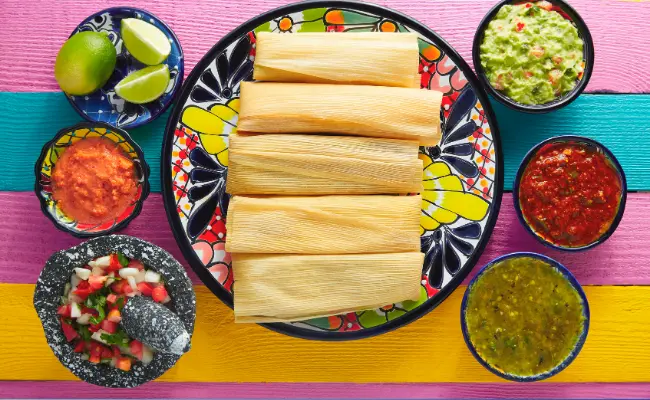
As the bond between humans and their four-legged companions grows stronger, pet owners often find themselves curious about sharing various aspects of their lives, including food. One question that arises is, “Can dogs eat tamales?” Tamales, with their flavorful fillings and wrapped in corn husks, are a traditional Mesoamerican dish enjoyed by many. However, when it comes to sharing human food with our furry friends, caution is essential, as not all human delicacies are safe for dogs to consume. In this article, we will explore the potential risks and benefits of feeding tamales to dogs, as well as alternative safe treats to keep our canine companions happy and healthy.
What Are Tamales?

Tamales are a unique pre-Columbian dish believed to have originated in Mesoamerica. They consist of corn dough (masa) filled with various ingredients, wrapped in banana leaves or corn husks, and then steamed.
Archaeological evidence shows that ancient civilizations like the Aztecs and Mayans enjoyed simple tamales made with beans and squash. Over time, tamales evolved, incorporating chicken, pork, olives, raisins, and other ingredients introduced by Europeans.
Today, they come in various regional variations and names across Central and South America. Tamales have also gained popularity in the Caribbean Islands and the United States.
The flavorful masa is made from dried cornmeal mixed with broth, lard, and seasonings, while fillings range from basic to elaborate, often featuring slow-cooked meats, vegetables, cheeses, and fruits.
Wrapped and steamed, tamales offer a portable and delicious culinary experience enjoyed worldwide.
Can Dogs Eat Tamale?
No, dogs should not eat tamales. While tamales may be a delicious and convenient human dish, they are not safe for dogs to consume.
Tamales typically contain ingredients that are harmful to dogs, such as onions, garlic, and spices, which can be toxic and cause digestive upset or more serious health issues. Moreover, the corn-based masa and the filling might be difficult for dogs to digest properly.
Additionally, the wrapping, whether it’s banana leaves or corn husks, can pose a choking hazard or lead to intestinal blockage if ingested.
It’s crucial to avoid feeding human foods, especially those with potentially harmful ingredients, to your canine companion. Instead, stick to a balanced and appropriate diet formulated for dogs to ensure their health and well-being.
If you suspect your dog has consumed tamales or any other toxic food, contact your veterinarian immediately for proper guidance and care.
Related Post: Can Dogs Eat Cheerios? Safe or Risky Snacking?
The Risks of Feeding Tamales to Dogs: Understanding the Dangers and Safe Alternatives

Feeding tamales to our dogs is not recommended for several crucial reasons. While this traditional dish may be a delightful treat for humans, it poses potential risks and health hazards for our canine companions.
1. Toxic Ingredients: Tamales often contain ingredients that are toxic to dogs, such as onions and garlic. These ingredients belong to the Allium family and can lead to a condition known as hemolytic anemia in dogs, where red blood cells are destroyed, causing weakness, lethargy, and even life-threatening consequences.
2. Spices and Seasonings: The spices and seasonings commonly used in tamales, such as chili powder, cumin, and pepper, can be irritating to a dog’s gastrointestinal tract. Spicy foods can cause stomach upset, vomiting, and diarrhea in dogs, making them uncomfortable and dehydrated.
3. Corn-Based Masa: The corn-based masa used in tamales may not sit well with a dog’s digestive system. Dogs are primarily meat-eaters, and their digestive enzymes are not optimized for breaking down complex carbohydrates like corn. Feeding them corn-based foods can lead to indigestion and gastrointestinal distress.
Related Post: Can Dogs Eat Yellow Rice?
4. Fatty Fillings: Tamales often contain fatty fillings like pork or cheese. Feeding such high-fat foods to dogs can lead to pancreatitis, a painful and potentially life-threatening inflammation of the pancreas.
5. Wrapping Hazards: The wrapping used in tamales, whether it’s banana leaves or corn husks, can be a choking hazard if ingested by dogs. Swallowing large pieces of these materials can also cause intestinal blockages, leading to severe discomfort and requiring surgical intervention.
6. Nutritional Imbalance: Tamales are not formulated to meet a dog’s nutritional needs. They lack essential nutrients that are vital for a dog’s health and can lead to deficiencies if consumed regularly.
7. Overweight and Obesity: Regularly feeding tamales or other high-calorie human foods can contribute to weight gain and obesity in dogs. Obesity increases the risk of various health issues, like joint problems, heart disease, and diabetes.
In summary, offering tamales or any human food to dogs is not advisable due to the potential harm caused by toxic ingredients, spices, indigestible corn-based masa, fatty fillings, choking hazards, and nutritional imbalances. To ensure our furry friends remain healthy and happy, it’s best to stick to a well-balanced and appropriate diet formulated specifically for dogs, avoiding the temptation to share our own meals with them. If you suspect your dog has ingested tamales or any other harmful food, consult your veterinarian promptly for appropriate advice and care.
Related Post: Can Dogs Eat Orange Chicken?
Safe Alternatives
1. Lean Cooked Meat: Dogs can enjoy lean, cooked meats like chicken, turkey, or beef in moderation. Ensure that the meat is free from bones, skin, and added seasonings. Cook the meat thoroughly to eliminate any potential harmful bacteria.
2. Plain Cooked Vegetables: Certain vegetables are safe for dogs, such as carrots, green beans, and sweet potatoes. These can be cooked and offered as treats or mixed into their regular dog food.
3. Fruits in Moderation: Some fruits are safe for dogs, but they should be given in moderation due to their natural sugar content. Offer small portions of dog-friendly fruits like apples, blueberries, and watermelon.
4. Dog-Specific Treats: Choose commercially available dog treats that are formulated to meet their nutritional needs. Look for treats with simple and natural ingredients, free from harmful additives and preservatives.
5. Peanut Butter: Dogs generally love peanut butter, but be sure to use only the natural variety without added sugars or xylitol, which is toxic to dogs.
6. Dental Chews and Bones: Dental chews and appropriate-sized bones designed for dogs can serve as satisfying treats while promoting dental health.
7. Frozen Treats: During hot weather, frozen treats made from dog-safe ingredients like yogurt, mashed banana, and peanut butter can be a refreshing and safe option.
Always consult your veterinarian before introducing new foods to your dog’s diet, especially if they have any health conditions or allergies. Remember that treats should only make up a small portion of your dog’s overall diet, and a balanced commercial dog food should be their primary source of nutrition. By understanding the risks associated with certain human foods and offering safe alternatives, we can ensure our beloved dogs stay healthy and happy for years to come.
Related Post: Can Dogs Eat Tuna?
The Nutritional Considerations: Why Tamales Are Not a Suitable Diet for Dogs
While tamales may contain some ingredients that offer nutritional benefits to humans, they do not provide the same advantages to dogs. Dogs have specific dietary requirements that differ from humans, and tamales are not formulated to meet their nutritional needs adequately. In fact, feeding tamales to your dog can be potentially harmful due to the reasons mentioned earlier, such as the inclusion of toxic ingredients, spices, and high-fat fillings that can lead to health issues like gastrointestinal problems, pancreatitis, and obesity.
To ensure your dog receives the necessary nutrients for optimal health, it is best to stick to a well-balanced and commercially prepared dog food that is specifically formulated for their age, size, and activity level. High-quality dog foods are designed to provide the essential proteins, carbohydrates, fats, vitamins, and minerals that dogs require for proper growth, energy, and overall well-being.
If you are uncertain about your dog’s nutritional needs or are considering introducing any new food items to their diet, consult with your veterinarian. They can recommend a suitable diet plan tailored to your dog’s individual needs, helping to keep them healthy and thriving. Remember, the best way to show love to your canine companion is by providing them with a safe and nutritionally appropriate diet.
Related Post: Can Dogs Eat Acai? Exploring the Safety and Benefits
What To Do If Your Dog Eats A Tamale?

If your dog accidentally eats a tamale, it’s essential to monitor them closely and take appropriate actions depending on the situation. While a single accidental ingestion may not cause severe harm in most cases, the reaction can vary depending on the size of your dog, the quantity consumed, and the specific ingredients in the tamale. Here’s what you should do if your dog eats a tamale:
1. Assess the Situation: Try to determine how much of the tamale your dog consumed and whether any toxic ingredients, such as onions or garlic, were present. This information will be helpful when you consult your veterinarian.
2. Observe for Symptoms: Keep a close eye on your dog for any signs of discomfort, vomiting, diarrhea, lethargy, or unusual behavior. If you notice any concerning symptoms, contact your veterinarian immediately.
3. Contact Your Veterinarian: If you are unsure about the ingredients or quantity your dog consumed or if your dog exhibits any concerning symptoms, contact your veterinarian right away. They can provide guidance based on your dog’s specific situation and advise you on the best course of action.
4. Do Not Induce Vomiting: Avoid trying to induce vomiting in your dog without consulting your veterinarian first. In some cases, inducing vomiting may not be safe or appropriate, depending on the circumstances.
5. Prevent Future Incidents: Take measures to prevent your dog from accessing human foods and potentially harmful items in the future. Keep food items, including tamales, out of reach and secure your trash cans to avoid scavenging.
6. Stick to a Dog-Safe Diet: Ensure your dog is on a well-balanced and nutritionally appropriate dog food diet to prevent them from seeking out human foods.
Remember, even if your dog seems fine after consuming a tamale, it’s always a good idea to contact your veterinarian for guidance. Early intervention and professional advice can prevent potential complications and ensure your dog’s well-being.
Related Post: Can Dogs Eat Couscous? How Much Is Safe?
Conclusion
Tamales are not suitable for dogs due to the potential risks associated with toxic ingredients, spices, and fatty fillings. Feeding tamales to dogs can lead to gastrointestinal upset, pancreatitis, choking hazards, and nutritional imbalances. It’s crucial for pet owners to be mindful of what they offer their canine companions and to avoid sharing human foods, especially those that could be harmful. Instead, provide dogs with a well-balanced and nutritionally appropriate diet formulated specifically for their needs. If your dog accidentally ingests a tamale, closely monitor their condition and seek veterinary advice if any concerning symptoms arise. Prioritizing your dog’s health and safety by offering them a proper diet will ensure they live a happy and healthy life as a cherished member of your family.



